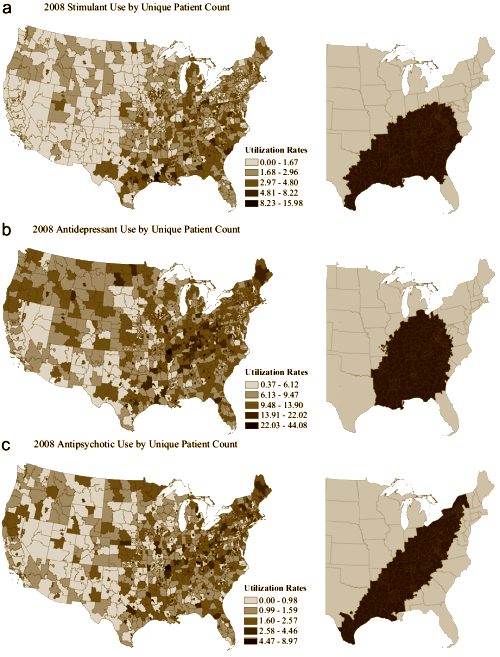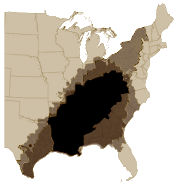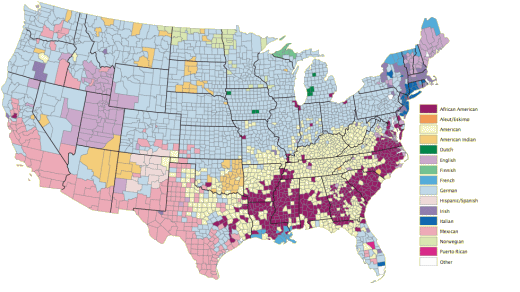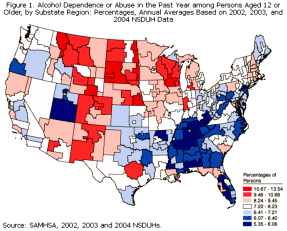The geography of antidepressant, antipsychotic, and stimulant utilization in the United States.
by King M and Essick C
Health & Place. 2013 20:32-38.
This paper analyzes local and regional geographic variability in the use of antidepressant, antipsychotic and stimulant medications in the United States. Using a data set that covers 60% of prescriptions written in the United States, we find that use of antidepressants in three digit postal codes ranged from less than 1% of residents to more than 40% residents. Stimulant and antipsychotic use exhibited similar levels of local geographic variability. A Kulldorf Spatial Scan identified clusters of elevated use of antidepressants [RR 1.46; p<0.001], antipsychotics [RR 1.42; p<0.001], and stimulants [RR 1.77; p<0.001]. Using a multilevel model, we find that access to health care, insurance coverage and pharmaceutical marketing efforts explain much of the geographic variation in use.

There are a couple of articles in the New Haven Register and the Yale Daily News that discuss their findings and the correlations they could identify. Only the stimulant use correlated with the distribution of treated disorder [ADD]. The authors focused on the pharmaceutical company’s efforts in trying to unravel the meaning of this distribution and found some interesting correlations.
 When I looked at those maps, I thought something else – more about the people in those areas than about external explanations. I superimposed the "clusters," and thought it even more strongly. The very dark spot which is common to all three clusters is very familiar – it’s the world of the Southern Appalachians, where our people are from and we’ve spent our lives. It’s a culturally distinct place. So my comments are biased from the start because I was looking at my known world and wondering why it was an epicenter for the use of psychoactive medications. I wouldn’t have thought that last week, but there it is in bas relief.
When I looked at those maps, I thought something else – more about the people in those areas than about external explanations. I superimposed the "clusters," and thought it even more strongly. The very dark spot which is common to all three clusters is very familiar – it’s the world of the Southern Appalachians, where our people are from and we’ve spent our lives. It’s a culturally distinct place. So my comments are biased from the start because I was looking at my known world and wondering why it was an epicenter for the use of psychoactive medications. I wouldn’t have thought that last week, but there it is in bas relief.
I thought of one of my favorite maps – one I ran across a few years back looking at the 2008 election returns. It’s a US ethnicity map that shows what people say their ethnicity is on a census form – the predominant ethnicity by county [click the map for the original to see the legend]:
For my purposes, there are two groups of interest: African-Americans and Americans [light yellow]. The people who put American on the census aren’t just being patriotic, they don’t know where their ancestors came from. They’re descended from the waves of early Caucasian immigrants who fled to the US, then fled the colonies, and settled in the Appalachian mountains and along the southern frontier. They then proceeded to intermarry. They see themselves as Americans because there’s nothing else to see themselves as. They are patriotic [in a regional sort of way] for obvious reasons and the racial divide is by color, not country of origin. Like the African-Americans, Americans trace their family histories here in this country. So I was obviously wondering why this group was such a mark for medication. Then I thought of another map to look for. I wondered how the psychotropic drug use correlated with alcohol abuse [red is high, blue is low]:
Not bad. Now I could take off on a tangent making up stories about why the denizens of the southern and appalachian wild might have an inverse relationship between psychotropic drug use and alcohol abuse, but I’m too scientific to let such thoughts run too wild – at least in public. By the way, that blue part on the last map fits the "Bible Belt" too. That’s another place to let the imagination soar. And for that matter, there’s plenty of poverty in those same parts. So much to speculate about when you’re an old man with a good Internet connection.


When looking at your maps, dr Nardo, my immediate reaction was that the darkest colour markings seemed to follow the Appalachian mountain range – as I remember it from a trip I took in a Willis jeep, to see more of America than the Hudson valley,Manhattan, Boston, Providence and Maine.
Poverty is the word you use at the end of your post. The poverty I saw, ages ago, unprepared, as it was not talked about, not reported in main stream media in Europe and US, not in the Doris Day, Roy Rogers, Esther Williams movies we were treated to in the after war years in Europe. The poverty I saw made a deep and lasting impression.
I recently saw Beasts of the Southern Wild, the glaring social injustice, heritable in generations for want of well-directed politics of inclusion. In such a society few Hushpuppies survive with spirits unbroken. Sadly, they are easy prey.
berit bj,
So you what I mean by a “a culturally distinct place.” It’s better now than when I was a kid, but still anything but good in pockets throughout the whole area – black and white. Psychotropic meds don’t do much for poverty…
poverty 2000 census
FYI:
http://www.eatg.org/news/167702/Pharma_should_not_publish_raw_data,_says_former_ABPI_head_
http://1boringoldman.com/index.php/2013/02/05/thanks-to-robert-gibbons/
This is fascinating. I suggest it has more to do with hospital and clinical practices leaning on “shut-up pills.”
I was thinking something sort of like that, Altostrata. Having been at the mercy of state services in Texas for a short time, I can attest that they spent very little time with patients to do anything but write prescriptions. After four years on a dose of lithium sufficient to make me completely dysfunctional, I discovered that you were supposed to have your blood tested while you were on it. A psychiatric institution with low, low funding and few available resources to refer patients to for concrete assistance cannot do much else.
It wasn’t until I got a computer and saw the prices on medical journals that I stopped being angry with them for being so far behind in their field.
Annon,
Of course the ABPI says “Pharma should not publish raw data.” That’s what they’re for…
Alto,
Patient + Sx = Rx
Wiley,
Texas, home of TMAP…
1BOM,
Fair point.
1BOM,
However, Dr. Ben Goldacre isn’t asking for it either: “We’re calling for three things. We want all trials to be registered, including retrospectively, so that we know about all the trials that have been done. We’re calling for all results to be reported in brief summary formats. And lastly we’re asking for full clinical study reports. What we’re not asking for is any patient confidential information.”
http://www.medpagetoday.com/PublicHealthPolicy/ClinicalTrials/37506
Would that have been enough in the case of Study 329?
In the case of the Gibbons paper?
And, I remain not entirely sure what distinguished alltrials, and GSK’s current support, from this:
http://dbt.consultantlive.com/display/article/1145628/1404221
I’m in a “culturally distinct place” in the Bible belt of Norway, sunday morning, church bells ringing, sun, ice and snow on a landscape, as lovely as landscapes of Appalachia, different and yet alike. Poverty here too, less, not as visible, though easy to see once you’ve been in close contact with people marginalized by forces stronger than the individual, pills to sleep, pills to hurt less more easily obtained than a new job.
Walking on a path outside a fence somewhere in the Appalachia in the sixties, I was shouted at by a man on the other side, and told to get off his property. His voice, face and the hunting rifle pointed at me did not invite conversation. White, as the other few people I saw.
An afterthought. There are other extremes of “culturally distinct” pockets and places, stranger to me than the poor of America, of Norway too, that I knew nothing about till meeting it face to face. Palacial dwellings in Rhode Island and New York, French butlers serving coctails to the masters, even on the rocky beach of an uninhabited island up north… easier for a camel than a rich man to pass through a needle’s eye… conquering the world but losing one’s soul… Psychiatry is lost, I think, in spite of the good people doing their best. Hopefully better politics will grow from the ashes of selfdestruction by way of ambition, greed, money.
Poor areas usually raise ignorant people. It wouldn’t surprise me they would have a higher incidence of accepting drugs to control child behavior, or just a higher incidence of accepting drugs from doctors in general.
I often wondered how the perception of antipsychotics in particular changed over time. Drugs that used to be refereed to as “reversible chemical lobotomies” in the 1950’s are now “mood stabilizers” safe for widespread use in children.
As for stimulants, it was similar change in perception by physicians. In the 1990’s it was believed stimulants worked differently in children with ADHD then normal adults and produced an opposite ‘calming’ effect. Eventually, the ‘assumption’ was proven incorrect in science publications – amphetamines and other stimulants had the same effect in all ages that took them, adhd or not.
Now there are non-psychiatrist physicians who publicly declare we have given up on modifying the environment for the poor, so we have to ‘modify the child’ by giving them Adderall to ‘improve their academic performance’.
http://www.nytimes.com/2012/10/09/health/attention-disorder-or-not-children-prescribed-pills-to-help-in-school.html?pagewanted=all&_r=0
Forbes also wrote an article on the subject:
http://www.forbes.com/sites/emilywillingham/2012/10/09/adhd-drugs-for-children-who-dont-have-adhd-is-it-ok/
It sure leaves room for a lot of speculation open as to why or even how.
Speaking of twitter (well, recently at least):
Myalgic Encephalomye @MyalgicEncephal
#alltrials does not call for publication of raw data from all trials. Only ‘results” which can be cooked, from clinical trials. #badpharma
They appear to address this to some extent in the their discussions here:
http://www.alltrials.net/wp-content/uploads/2013/01/Missing-trials-briefing-note.pdf
Another take on the map of antidepressant use from Alternet: http://www.alternet.org/belief/when-god-not-enough-religious-states-have-highest-rates-anti-depressant-use
Alto,
Thanks for that link. When I read the above article about the epidemiology of psychotrophics, I was immediately struck with that association. It is as well as the area where alcohol is a sin, but medications aren’t. Paradoxically, there’s a lot of drug abuse in these same areas. Down home religion, poverty, drug abuse, and psychotrophic drugs are the new American Gothic…